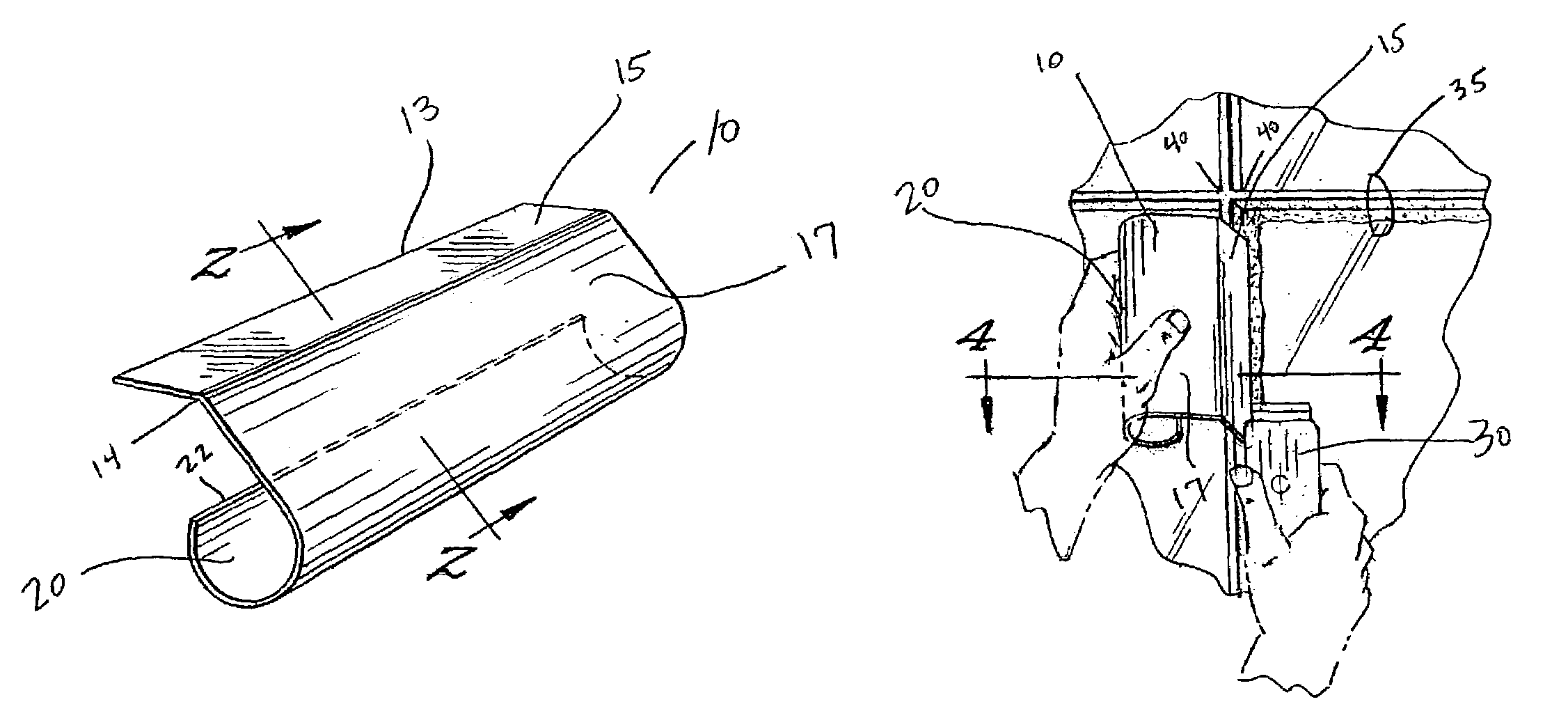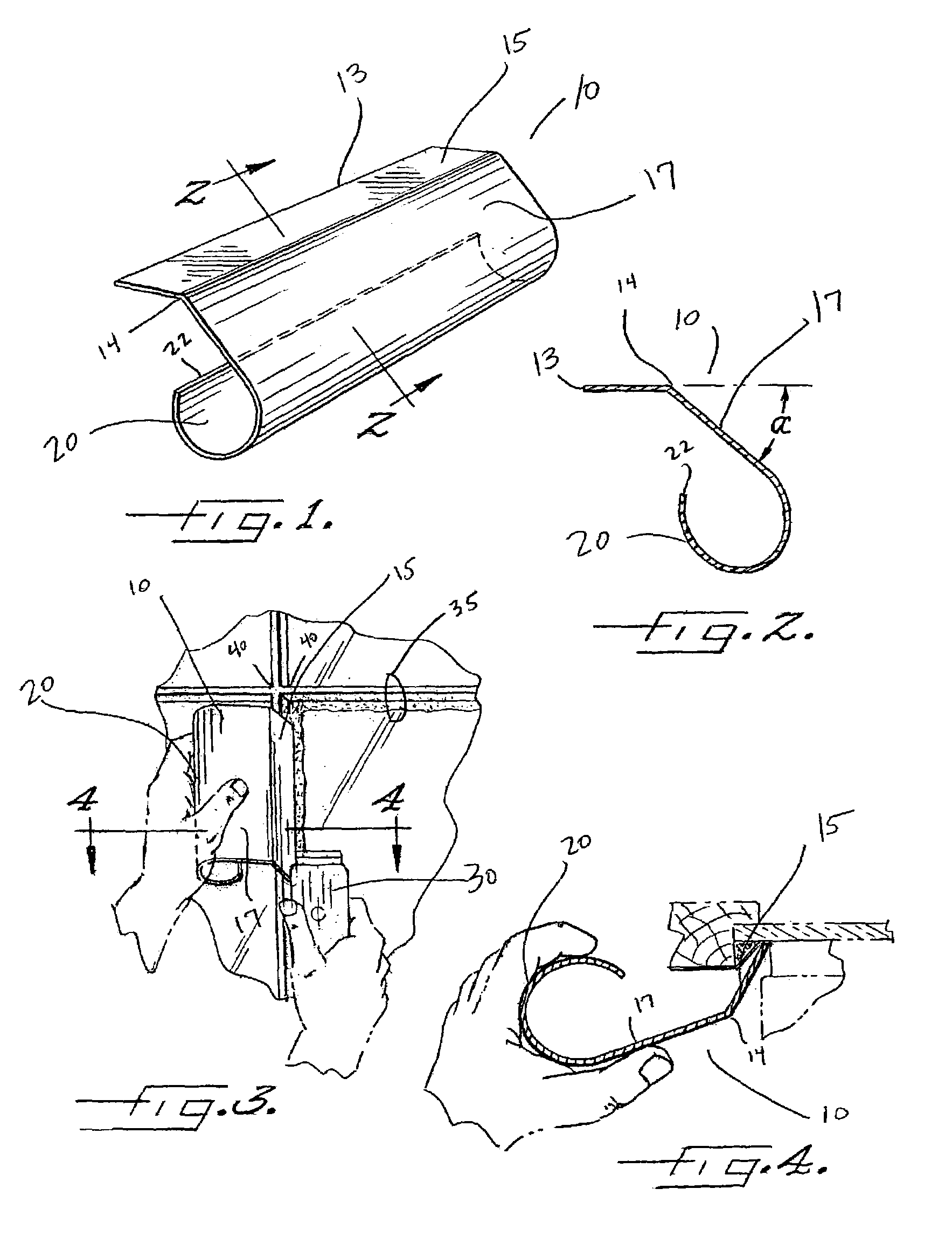Ergonomic shielding tool for processing a surface
a shielding tool and ergonomic technology, applied in the field of ergonomic shielding tools, can solve the problems of easy damage to the user's hand, easy to fall off, and easy to damage the user's hand, and achieve the effect of prolonging the use without fatigue or injury
- Summary
- Abstract
- Description
- Claims
- Application Information
AI Technical Summary
Benefits of technology
Problems solved by technology
Method used
Image
Examples
first embodiment
[0036]In a first embodiment, the tool includes a single-piece body (10) of substantially uniform thickness with a straight edge (13) at a first end of the body. The user places the straight edge (13) against a surface to separate the surface into first and second regions on opposite sides of the straight edge. These separate portions of the surface may be distinctly processed, depending on the use at hand.
[0037]The body of the tool (10) may be made of a substantially planar sheet of material of substantially uniform thickness. The selected material can be metal, plastic, rubber, or any other convenient material that is formable into the desired shape with a straight edge (13) at a first end of the sheet. A sheet of formable material may be conveniently bent and curved to form the invention claimed here. Alternatively, common molding techniques are equally pertinent to fabricating the tool claimed herein. Shaping a single sheet of a material, such as a metal, is the simplest means of...
second embodiment
[0047]The second embodiment includes a single-piece body (10) having a substantially rectangular guide panel (15) with a guide edge (13) at one end. The guide edge (13) is straight, and in use, the guide edge (13) is placed flush against a surface. The guide edge (13) against a surface separates the surface into two regions on opposite sides of the guide edge (13).
[0048]The tool (10) further includes a shield panel (17) extending at an angle (a) from the guide panel (15), opposite the guide edge (13), to protect and cover a portion of the surface on one side of the guide edge (13). The portion of the surface on the opposite side of the guide edge (13) is exposed for further processing.
[0049]The second embodiment of the tool further includes a curved handle (20) extending from the shield panel (17), opposite the guide panel (15), for gripping the body (10) and holding the guide edge (13) against a surface. In use, when the straight guide edge (13) is flush against a surface, the shie...
fourth embodiment
[0069]The inventors herein also describe and claim a method of removing paint from a window held in place by a painted frame (35). This fourth embodiment of the claimed invention is an ergonomic method of removing dried paint from a window while holding an ergonomic shielding tool (10) in one hand.
[0070]The shielding tool (10) has a one-piece body with a substantially rectangular guide panel (15) with a straight guide edge (13) at one end, a substantially planar shield panel (17) extending at an angle from the guide panel (15) opposite the guide edge (13), and a rounded handle (20) extending from the shield panel (17) opposite the guide panel (15). According to the method herein, the user grips the shielding tool (10) so that the rounded handle (20) extends along the palm of the user's hand.
[0071]The user places the guide edge (13) of the shielding tool against a window so that the shield panel (17) covers a first portion of the window, and a second portion of the window remains unc...
PUM
 Login to View More
Login to View More Abstract
Description
Claims
Application Information
 Login to View More
Login to View More - R&D
- Intellectual Property
- Life Sciences
- Materials
- Tech Scout
- Unparalleled Data Quality
- Higher Quality Content
- 60% Fewer Hallucinations
Browse by: Latest US Patents, China's latest patents, Technical Efficacy Thesaurus, Application Domain, Technology Topic, Popular Technical Reports.
© 2025 PatSnap. All rights reserved.Legal|Privacy policy|Modern Slavery Act Transparency Statement|Sitemap|About US| Contact US: help@patsnap.com


